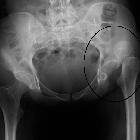Hüftluxation

Management of
femoral head fracture by Ganz surgical dislocation of the hip. A, B Preoperative radiograph of a male 28-year-old patient with right hip dislocation and fracture of the femoral head (Pipkin type 2 fracture)

Hip
dislocation • Lipohemarthrosis - hip joint - Ganzer Fall bei Radiopaedia


Traumatische
hintere Hüftluxation links ohne eindeutige ossäre Verletzung des Acetabulums. Man erkennt jedoch in der sagittalen Rekonstruktion (links unten) die (geringe) Impression des hinteren Pfannenrandes in den Femurkopf (analog einer Hill-Sachs-Delle).

Hip
dislocation • Anterior dislocation of the hip - Ganzer Fall bei Radiopaedia

Osteoarthritis
• Advanced hip osteoarthritis - Ganzer Fall bei Radiopaedia

Hip
dislocation • Hip dislocation - inferior - Ganzer Fall bei Radiopaedia

Hip
dislocation • Dislocated hip prosthesis - Ganzer Fall bei Radiopaedia

Hip
dislocation • Developmental dysplasia of the hip - Ganzer Fall bei Radiopaedia


Hip
dislocation • Hip joint dislocation - Ganzer Fall bei Radiopaedia

Zentrale
Hüftluxation bei einer 40-jährigen. Der Hüftkopf ist im Sinne einer Luxationsfraktur nach zentral durch das Azetabulum eingebrochen und verlagert hier die Fragmente gegen das Beckeninnere. Links Computertomographie in koronarer Rekonstruktion, rechts Volumen-Rendering-Darstellung des linken Hemipelvis mit Blick von innen.

Management of
femoral head fracture by Ganz surgical dislocation of the hip. A Preoperative CT scan showing head femur fracture (axial view). B Preoperative CT scan showing head femur fracture (coronal view)

Management of
femoral head fracture by Ganz surgical dislocation of the hip. Preoperative radiograph of a female 35-year-old patient with left hip dislocation and fracture of the femoral head (Pipkin type 1 fracture)



School ager
with right hip pain after a motor vehicle accident. AP radiograph of the pelvis (on a trauma board) shows the right femoral head to be dislocated posteriorly.The diagnosis was right traumatic posterior hip dislocation. There are no fractures.
Hip dislocation is a relatively rare entity and may be congenital or acquired.
Epidemiology
Hip dislocations account for ~5% of all dislocations .
Pathology
There are numerous patterns of dislocation :
- posterior hip dislocation (most common ~85%)
- anterior hip dislocation (~10%)
- inferior (obturator) hip dislocation
- superior (pubic/iliac) hip dislocation (rare)
- central hip dislocation (protrusio) - always associated with acetabular fracture
Etiology
Acquired
Acquired hip dislocation is normally associated with high-speed trauma, with motor vehicle collisions account half of the dislocation with other causes such as falls and sports injuries, less common .
Hip dislocation is the second most common complication of hip joint replacements and occurs in ~5% (range 0.5-10%) of patients with ~60% of dislocations being recurrent .
Congenital
Congenital hip dislocation is now considered part of the spectrum of developmental dysplasia of the hip (see the article for further information) .
Complications
- avascular necrosis: particularly if reduction postponed more than 24 hours
Siehe auch:
- Zentrale Hüftluxation
- hintere Hüftluxation
- Luxatio iliaca (hinten oben)
- Luxatio ischiadica (hinten unten)
- vordere Hüftluxation
- Luxatio obturatoria (vorne unten)
- Luxatio suprapubica (vorne oben)
- kindliche Hüftluxation
und weiter:

 Assoziationen und Differentialdiagnosen zu Hüftluxation:
Assoziationen und Differentialdiagnosen zu Hüftluxation:

